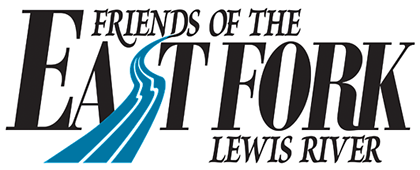Winter 2021 News and Planning Update
The FOEF Board of Directors has been busy creating a new 2021 programs plan and new projects that can be accomplished despite the impacts of the Corona Virus on people and outdoor activities.
We are expanding our stream temperature monitoring program and will be adding at least 3 more continuous (HoBo) temperature recorders in the lower East Fork and tributaries (Manly Road Creek and Mason Creek and Mill Creek North). This data is critical to identifying where and what kind of projects to prioritize in the lower East Fork.
We will be installing more “Beaver Deceiver” pipe systems in beaver dams on river side-channels and tributary streams which will allow salmon fry movement and continued flow of cooler water into pools during the summer critical low flow period. That time period is when many salmon fry and juveniles are at high risk and holding pools in key tributaries can dry up and strand these fish.
Our intensive collaborative involvement in working on restoration of the old Ridgefield Pits along with the Columbia River Estuary Partnership in the lower East Fork is being expanded with the help of our new FOEF Board member Jim Byrne who is a retired WA State F&W Regional Fish Biologist.
The Manly Road Creek salmon fry pool sediment removal project was completed by late last fall with the generous help of Colf Construction Company. A month or so later the WA F&W as well as some FOEF members observed Coho salmon spawning on the new gravel above the refurbished in-channel fish pool.
Working with land owns on Mason Creek we will be designing a project to improve a instream pool that was damaged by sediment from an upstream culvert failure. Mason Creek is a tributary of the lower East Fork and has been identified by recent studies done by the WA F&W to be a very productive small stream and sustains a population of steelhead as well as Coho salmon. This supports a study done by Bonneville Power on tributaries in the Columbia Basin that found these small tributaries play a critical role in sustaining fish populations in larger rivers within the Columbia River System. Mason Creek is one of several streams where the Dave Brown Wild Fish Rescue program is applied to rescue stranded salmon and steelhead fry when pools began to dry up.
Our field teaching assistance to the stream temperature and water quality monitoring students of the La Center High School Conservation and Environmental Class continues after making appropriate adjustments for the Covid Virus situation. Major adjustments were made to ensure protection compliance so that river monitoring projects could continue in the field. Their projects are focused on the lower East Fork and tributaries, including the East Fork at the Swanson property, lower Mason Creek, and also lower Manly Road Creek where there are two key salmon fry and juvenile instream rearing pools that empty into the East Fork. The class also does monitoring on Mill Creek North which is also nearby the outlet of Manly Road Creek where it empties into the East Fork.
In addition, the FOEF Board is increasing its effort to find more project work funding thru applying for various kinds of grants. We have been most fortunate in the past in obtaining project materials donations and hope this will continue. Last year we obtained thousands of dollars worth of root wads and stream fish habitat logs, thanks to the generous support of Pacific Power who gave us the logs that accumulated at their North Fork Lewis River power dam operations. In addition, other Washington companies and individuals have donated both money and materials to FOEF for projects and public involvement support work. Collaboration with the Healing Waters Veterans Group and the Clark-Skamania Fly Fishers provided us with timely field help from their members. In addition, a licensed very experienced drone pilot has been flying our project areas and giving us video and photo coverage.
In 2021 we intend to do more and better projects to improve the watershed and fisheries conditions in the East Fork Lewis River and tributaries. Again, do not hesitate to contact us if you have questions or would like to volunteer to help us to gather project data in the field or monitoring and project maintenance work.




